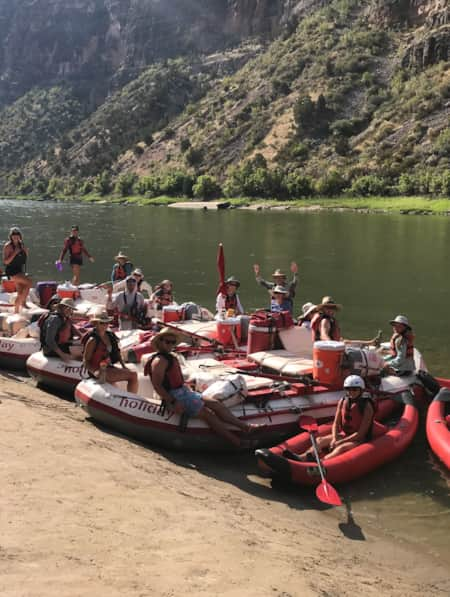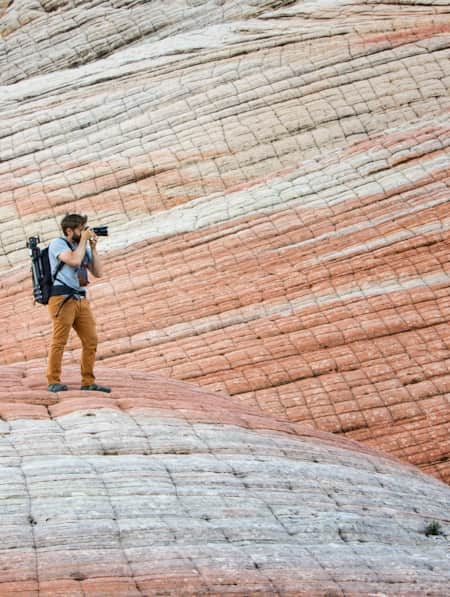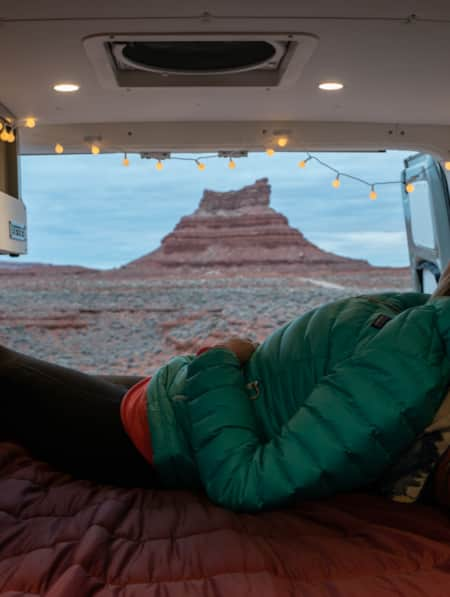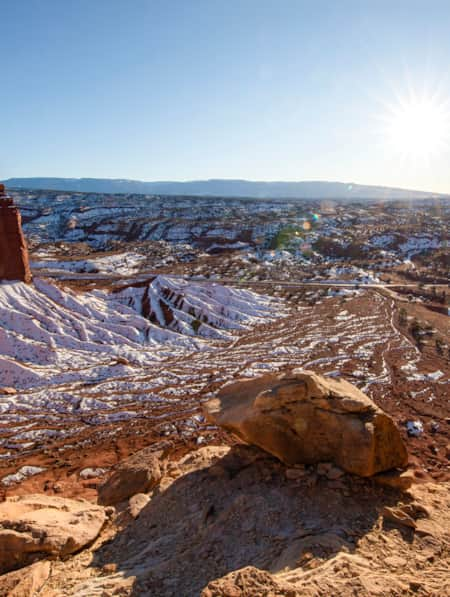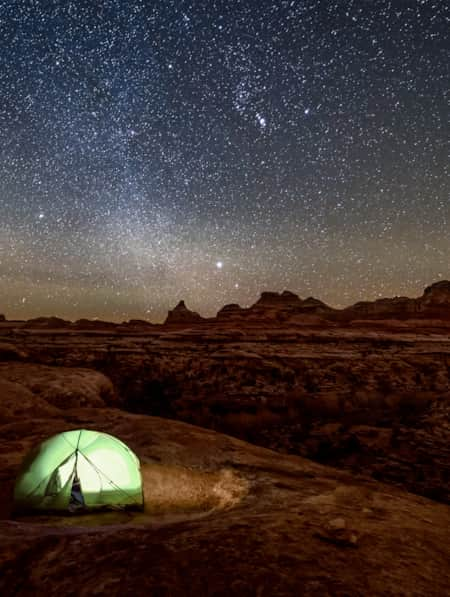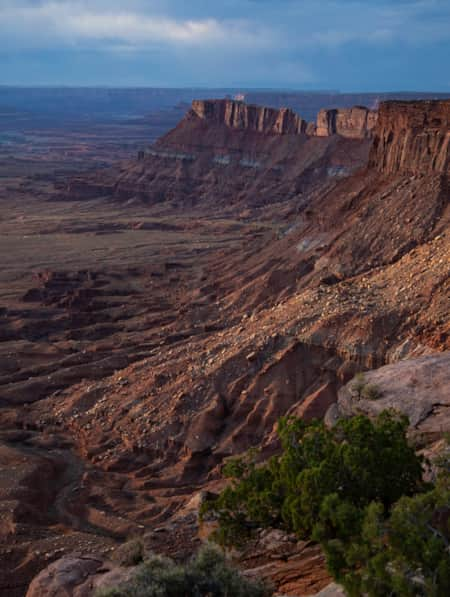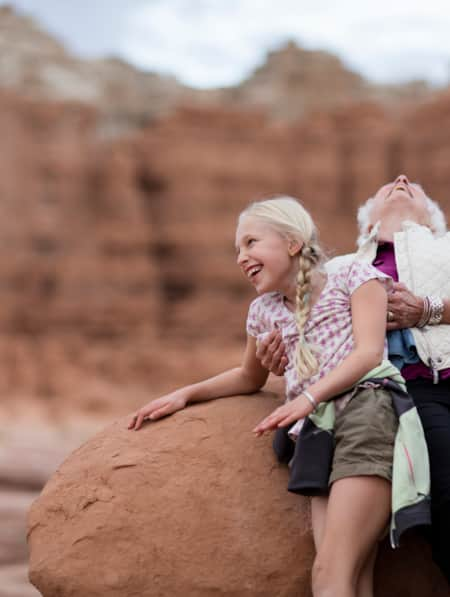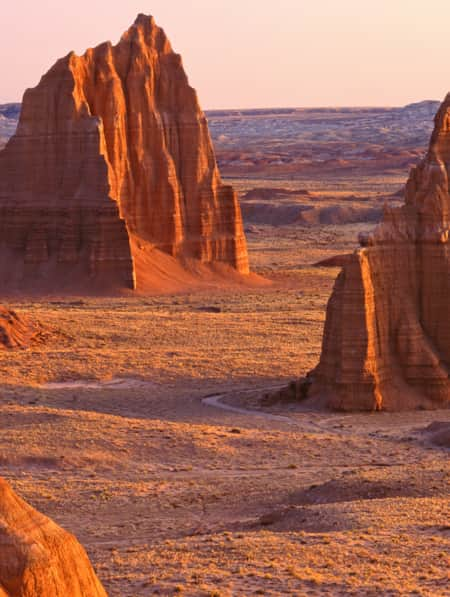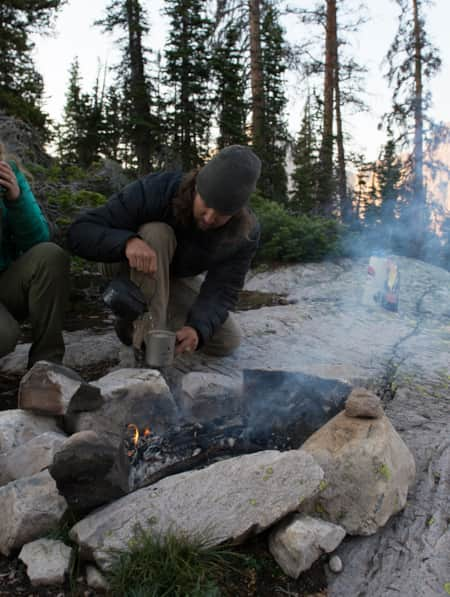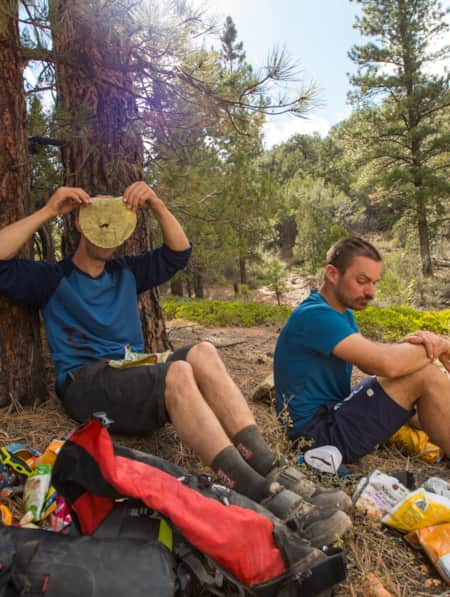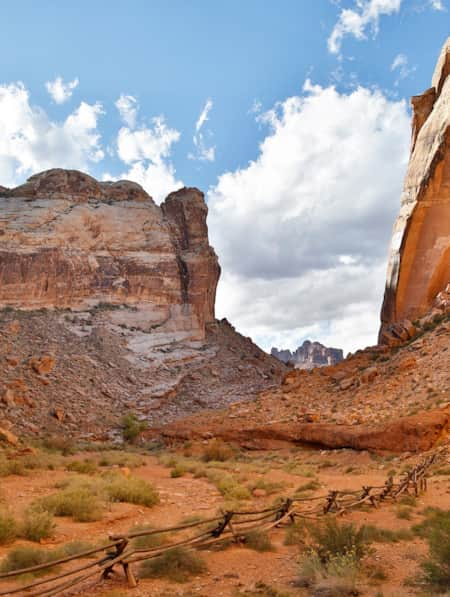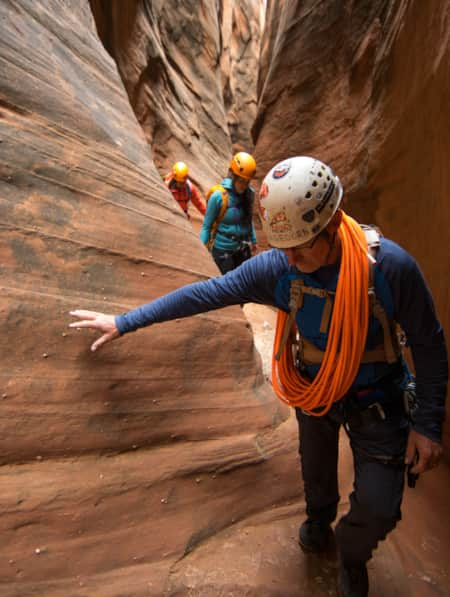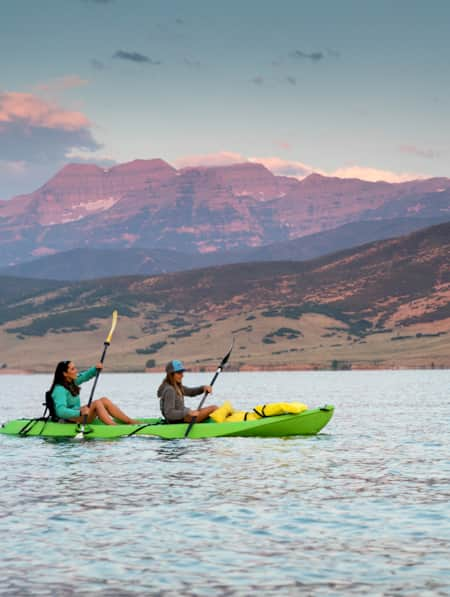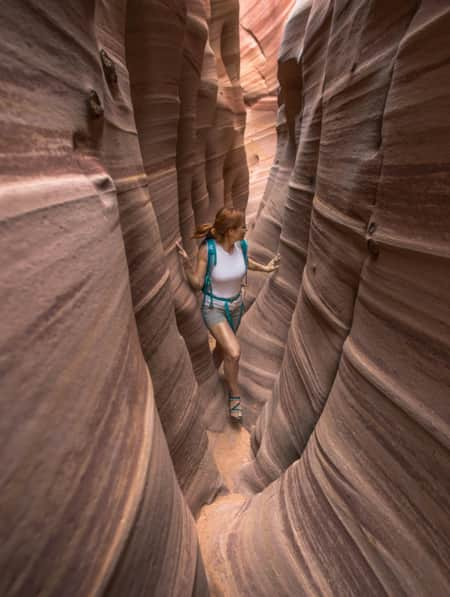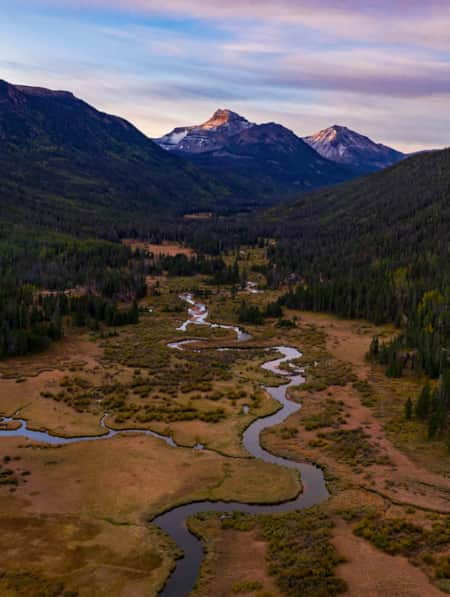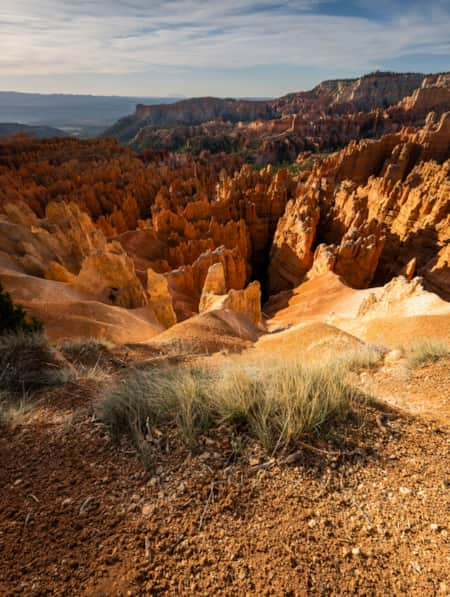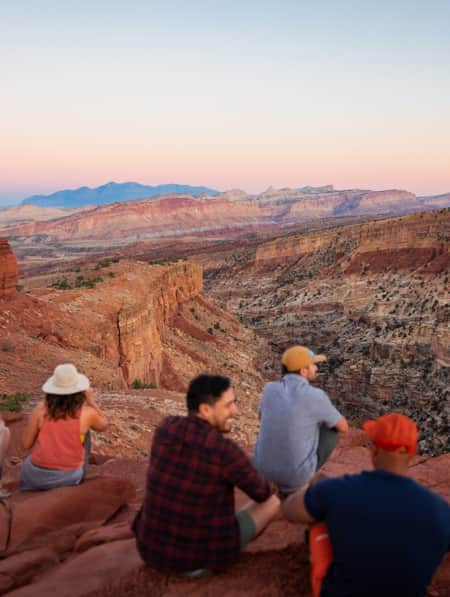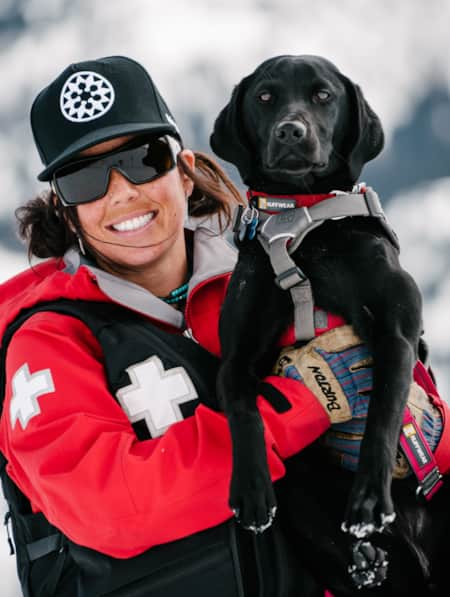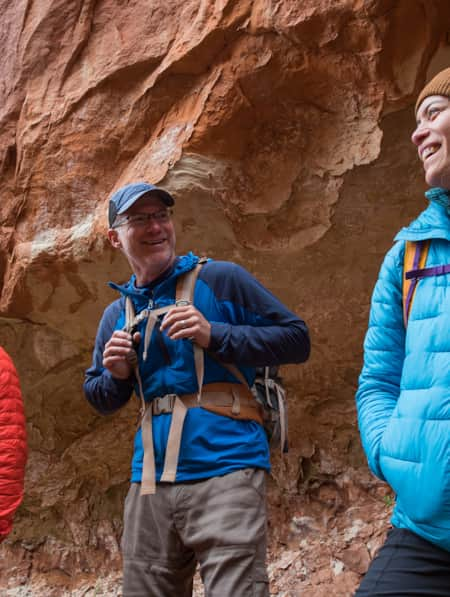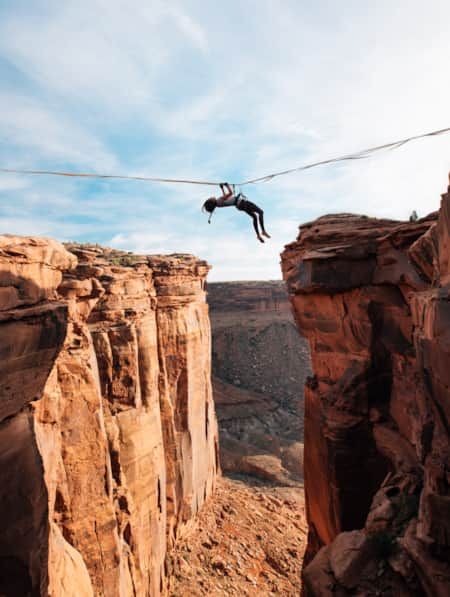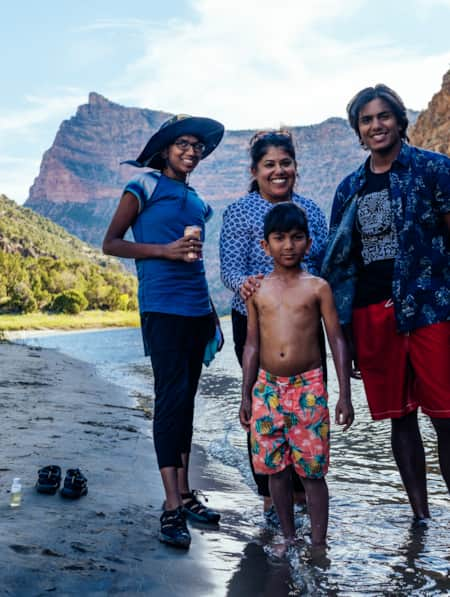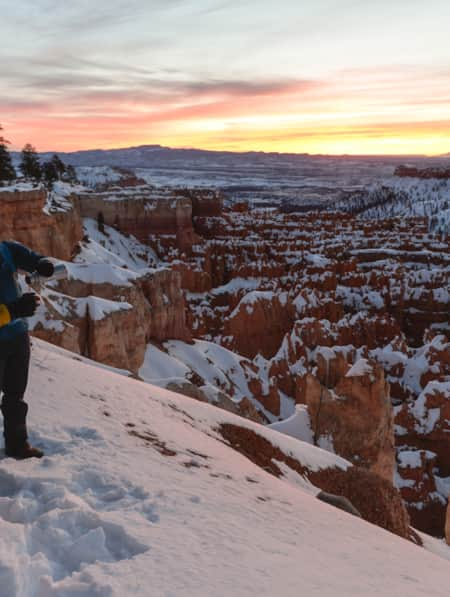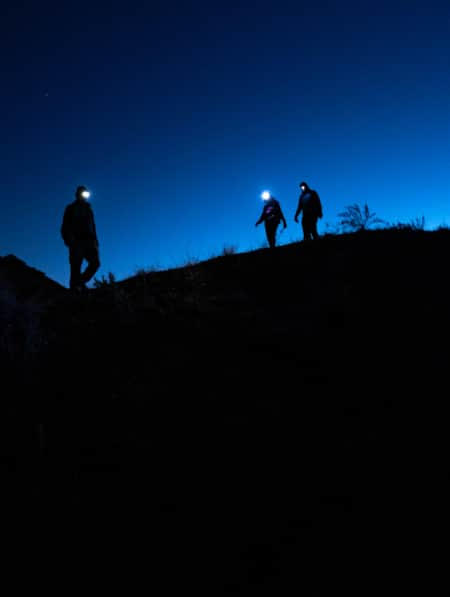Wandering: Between the Contours

November 10-12, 2016
Two days after the 2016 Presidential election, I loaded my pack and walked out the back door. Besides what I needed to sleep (no tent, no storms forecasted) I had two Tasty Bite meals, four hardboiled eggs, two packets of instant oatmeal, one of instant soup and three instant coffees. I had five bottles of various sizes filled with water — a bit more than a gallon total. I had my hiking poles. My cell phone and map were in my chest pocket, along with two pens and a pencil, a small black notebook.
I walked south into the ever-deepening gorge that runs around our house, protecting it from the unpredictable floods. Climbing out was more difficult, the smooth route I’d previously used eliminated by the last flood. I crossed the fence separating our lot from the one east of us and walked northeast toward the diagonal fence marking the end of Castle Valley proper and the beginning of land under the jurisdiction of the Bureau of Land Management (BLM). I opened the gate and stepped out onto Public Lands. (Read: “How to Camp on Utah’s BLM Lands”)
When I stopped momentarily to tighten my shoes, I didn’t realize my three pens dropped out of my pocket into the red sand.
A faint trail follows an old fence across the valley. My old legs felt better and better as I moved through the desert, between cactus and sage, following cow and deer paths with Castleton Tower as a compass point. (Read: "Soil Sleuth: Protecting Utah's Living Landscapes")
Lately, I’d been thinking and writing about the connection between the time one spends in the wilds and one’s need to contribute to the greater good. I’ve been circling around this idea for years and it may be what mentor, friend and brilliant writer, Bill Kittredge referred to when he said that his goal as a teacher was to “help his students find the one story that they will tell over and over the rest of their lives.” For me, this is an evolving story. It is based on the possibility that the modern lives we live have little in common with those we evolved to live, and hence, many of our problems. While this story moves back and forth, its forward direction is constant. It gets more specific with time and this past year I realized that it’s time alone in the solitude of a wild place that is most likely to motivate someone to want to contribute to the collective good, as opposed to seeking individual reward. Wandering pathless ways in the desert, everything I need strapped to my back, is, I believe is as close as most of us get these days, to the life evolution prepared us for. (Read: "Be Prepared for the Backcountry")
"Wandering pathless ways in the desert, everything I need strapped to my back, is, I believe is as close as most of us get these days, to the life evolution prepared us for."

The red rock desert is home to a rich biological soil crust — also known as “cryptobiotic crust” — which is actually living soil.

A view of Fisher Towers near Moab.
Although I had a predetermined direction I still felt as if I was wandering, like the poet Basho, my path divergent and varied. The rhythm of my alternating hiking poles, my steps, put me in that familiar trance where neither distance nor destination mattered.
Earlier gathering my gear in preparation for leaving, Terry said I was like a little kid, glowing with excitement. I guess I was. That excitement grew as I moved closer to the steep ridge line dropping south away from Castleton Tower and the pass separating what was familiar to me and what was not.
I crossed the BLM lands following deer paths, a pair of ravens accompanying me. Rather than taking the most direct route across the Loop Road, without thinking I dropped down the steep bank into the arroyo passing beneath it. Stopping briefly at the entrance to the culvert, I felt the thicker air inside, which seemed to keep the essences on either side from mixing with one another. As I entered and took a deep breath of the dense air, I opened up and felt committed to be open and conscious of any ‘ground truths’ that came to me over the next few days.
Believing that the portal led to an alternative world was required if that possibility was to exist. The culvert has been flattened by time and the weight of a million cars and trucks — I chose the reality that I was leaving something and entering something else, something new that I had three days to explore.
Although I’d walked up the wash that drained through the portal dozens of times, this was different. I moved quickly, like water, my joints smooth and my muscles warm. I was alert and eager and open, waiting for something to grab onto my attention, to flirt with me.
The most important aspect of my life to date, not counting my wife, Terry, my dogs and family, may be the time I’ve spent alone in wild solitude. All those hours running in the Wasatch and the Foothills above SLC. Those long climbs on skis, the rhythm creating some magic hypnotic effect. (Read: “Elevate Your Hiking with Mindfulness”)
I recognized that same familiar feeling as I moved up the drainage. Plus, I noticed the familiar pulsing which often occurs in Castle Valley, and as usual, I couldn’t tell whether I felt it or heard it.
Since I’m old and decrepit and since I have a heart condition (I was sure to take my nitroglycerin pills just in case) I marked a map with the route I intended to take, took a photo of it and sent it to Terry’s computer before I left. If I don’t come back on Saturday, you might call for a search, I’d told her. Show them this map, I’d told her.
At the pass I pulled out the map. I stood on an old road that long ago, was likely used by horse-drawn wagons, but only modern outdoor footwear tracks were visible in the loose dirt. My plan, which turned out to be overly ambitious, was to find a direct route east into Mary Jane Canyon, wander up it to where it joined Hell Roaring Creek and explore that drainage. I could stay on the old road angling north downhill through familiar territory. Or, I could turn south on a new route, along the upper edge of the drainage and then east along the lower end of Adobe Mesa’s long skirts.

The author stops briefly at the entrance to a culvert, flattened by time and the weight of a million cars and trucks.
Photo: Brooke Williams
"The most important aspect of my life to date...may be the time I’ve spent alone in wild solitude. All those hours running in the Wasatch and the Foothills above SLC. Those long climbs on skis, the rhythm creating some magic hypnotic effect."
The choice was between a meditative familiar walk and adventure/exploration in brand new territory. I felt, standing there reviewing my options, my body telling me that while I needed the meditation and peace of the wild world, I should go for the adventure (Read: “Finding Strength and Inspiration Deep in the Utah Desert”). I turned, dropped off the old into the unknown.
Traversing the next mile took me an hour. I dropped down a steep incline of soft dirt, following animals, who, I’ve learned over my time living in the desert, are dependable in finding their way in and out of canyons, which, there in the upper reaches of the Mary Jane drainage, fork and fork again and I imagine from space look like a circulatory system. I’m also familiar with the feeling of gravity and water being pulled down canyon and the force required to move against it. I knew I needed to stay has high as possible, like animals, which were my guides. Going down with the flow promised to end badly — at impossible pour-offs in slot canyons.
A great feeling awakened inside me — of adventure, of not knowing what was next. This feeling always comes with energy and excitement. I felt I was being carried, moved through the landscape on the back of some large soft animal with a dozen ancient paws. (Read: “Resiliency Road Trip”)
I floated beneath cliffs and among gigantic boulders and trees which also floated, albeit more slowly.
I needed to throttle back and recall my three rules: don’t do anything I can’t reverse; no jumping; step in the middle of things, not on their edges. (Read: “You're Inspired to Go Off the Beaten Path. Now What?”)
Whenever I thought I was stuck and might need to turn back, I found an animal track to follow. Deer and coyotes, the occasional bobcat.
Four times, I dropped into a small, veined canyon thinking that the tall, opposite side would be the last and I would stand on top and see the world spread out flat before me. And each time, I saw more of the same, unending cuts and fractures as if some huge fist was rising from beneath, cracking the entire surface of the earth the moment before it shattered into a million deep red pieces.
I found my way in and out of yet another gulch and sat on a boulder in the sun taking a drink of water. I worried about water — I’d seen none and wasn’t carrying enough to last the time I planned on being out. Eager to get moving in the day’s last light, I turned once more toward Adobe Mesa, and climbed to the top of the last gulch where the erosional cutting had had less time leaving the gorge less dramatic and more conducive to crossing.
"I dropped down a steep incline of soft dirt, following animals, who, I’ve learned over my time living in the desert, are dependable in finding their way in and out of canyons..."

Although the sun stayed strong, and since I had no firm destination (I wanted to stay as close as possible to the route I drew on Terry’s map, just in case…) I chose to stop and set up camp in the large beautiful opening I saw below me, beneath a mammoth juniper tree.
I made my way down and set up my simple camp as the shadow line moved across it like a massive curtain, pushing, pressurizing the air in front of it. Without a hint of movement the temperature dropped as if attached to gravity.
My pack — light in deference to my aging left knee — included a small camp chair, which I unrolled and sat in at the head of my sleeping bag, facing one of Adobe Mesa’s long arms as it caught fire in the late sun. To my left, I spread out within reach my tiny stove and cooking pot, a water bottle and my food sack. Right of me, I placed my book on top of my parka. I put on my hat and headlamp, which I would need in a few hours. My notebook was useless without pen or pencil, the likes of which I’d not been without ever. (Read: “How to Backcountry Camp Responsibly”)
I looked forward to cooking and eating but opted to wait for the sun to go down.
Two days before, Donald Trump had been elected President of the United States. As though that had happened in another time, in some far away and foreign place, I felt perfect. My body had performed well over difficult terrain. I had a perfect seat perfectly positioned where absolutely everything I needed was within immediate reach. No sound makes its own sound. I made mental notes about the different qualities of silence — thrumming replaced by vibrations overcome by what can only be described as buzzing. No movement. (Read: “It’s About Time We All Unplugged”)
No sound until raven’s wings slashed through the compressed light.
The last light of day turned the red soil around me purple. I wandered over to a small wash following the tracks of a small rodent. Nothing moved. There were no sounds. I’d love to know the physics involved when the lowering light increases the density of the air, thickening the solitude. The increasing darkness may actually be a soft thick blanket forming around the light, before putting it out. I was tired and sore, but I blamed the slowness with which I moved back to my small camp on the resistance of the thick silence.

Topographers using aerial photographs will have a hard time capturing all the intrigue of the desert landscape.
Photo: Brooke Williams
"Sitting there drenched in silence, cliff colors changing, I was beyond the hope of finding any order of words that would come even close to becoming that moment."

I’d written for years exploring the question why, in this modern age, we need wilderness. And Thoreau meant by, “in wildness is the preservation of the world.” These are words, and as I’ve discovered that while making words my vocation, words are not ‘things’…my job as a writer is to pick the word that is as close to the actual thing as possible. Sitting there drenched in silence, cliff colors changing, I was beyond the hope of finding any order of words that would come even close to becoming that moment (Read: "The Freedom of Wild Places"). As if my body was filled with chemicals that, when exposed to catalytic wildness, reacted, forming a new element, one necessary only to that moment.
I tucked myself back into my chair, pulling my sleeping bag up around my chest. Tasty Bite meals are perfect for short trips. Pad Thai for the first night, I wiped down the bag before placing it carefully in the boiling water, figuring I could reuse it in the morning. The rising moon, a few days from full, would make sleeping a problem.
I finished my pad Thai then I poured a few ounces of the still-steamy water into the plastic measuring cup I use for a dish and swirled it around, until the Tasty Bite remnants became suspended in the then soup-like liquid. Which I drank, knowing how precious water would become.
I pulled out my topo map, which in no way represented the actual terrain I’d spent the previous four hours crossing. No way could topographers using aerial photographs of this area capture all the intrigue possible within 40-foot contours. I found my camp on the map, but ignored what I had facing me in the morning.
Excerpt from "Mary Jane Wild: Two Walks and a Rant" by Brooke Williams. Homebound Publications, November, 2021.





